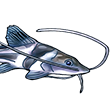Rohan Richardson wrote:Mate i would be very wary of volcanic rock simply for the fact that the Xingu River rocks are extremely old and trace element poor so any volcanic rock must be from an area that is equally as old and element poor (not just the sharp edges that are very dangerous). Being river rocks the elements have leached out to the point of literally being inert and are as smooth as a babies bum so that is the way to do a Xingu river tank(smoothed rock only). The good thing for you is that L46's are readily breedable and with the damming of the river approved they will need to be bred in captivity to possibly survive as a species so my advice is to get them happening as fast as you can. Rohan R

Rohan,
Your logic is flawed.
The volcanic rocks in the Xingu could contribute minerals still, raising the TDS in an aquarium. It is not a question of the age of the rocks in the river but that igneous rocka, granite and basalt are not very soluble to begin with but they are not completely neutral. Think EcoComplete substrate. It says right on the bag that it may increase hardness slightly. It is the high annual rain fall in the Xingu drainage that maintains soft water and allows the pH to drop from the leaching of the fallen litter of the water shed.
The rocks are naturally smoothed by years in fast flowing water.
Therefore TwoTankAmin gave the correct advice about the proper rocks and substrate to use in a Xingu River Biotope. He does raise more than a few H. zebra so I would listen to what he has to say. You were correct about this part.
Lace Rock has a high calcium carbonate if it is the type composed of the mineral Aragonite(Normally white or buff colored). It is popular in Rift lake fish tanks. The other form available is frothy volcanic glass(usually gray colored). The latter has many razor sharp edges although they are difficult to feel they are actually like frothy Obsidian and on the micro-scale are just as sharp.
Avid Trout fly fisherman. ·´¯`·...¸><)))º>




